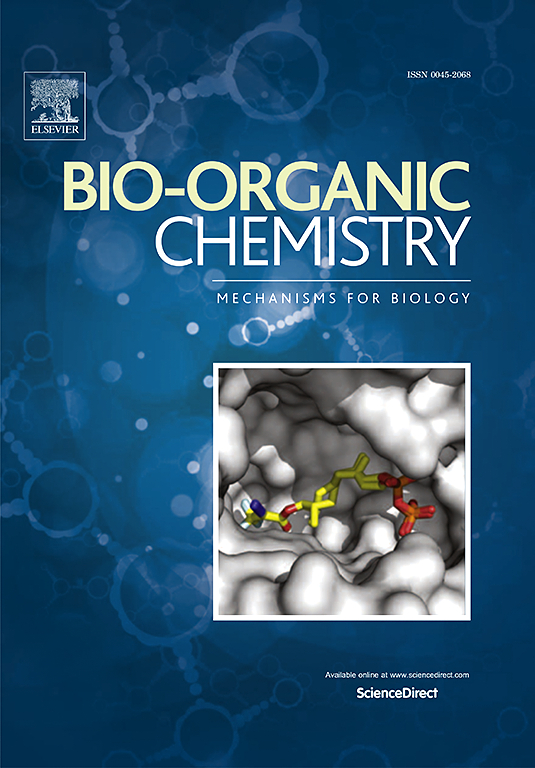综述了几种二价过渡金属配合物的抗炎、抗菌、抗癌和抗真菌性能
IF 4.5
2区 医学
Q1 BIOCHEMISTRY & MOLECULAR BIOLOGY
引用次数: 0
摘要
过渡金属配合物由于其特殊的生物作用,包括抗炎、抗菌、抗真菌和抗癌,已被公认为可能的治疗剂。本研究对铜(Cu)、钴(Co)、镍(Ni)、锰(Mn)、钯(Pd)、锌(Zn)、铂(Pt)金属(II)配合物的药理学角度进行了全面深入的探索。这些复合物显示出独特的配位化学和作用模式,有助于与生物靶标相互作用,包括DNA结合、酶抑制和活性氧的形成。所有金属(II)配合物的透视活性都有显著的潜在影响。Co(II)和Ni(II)配合物具有较好的抗菌和抗真菌作用,而Cu(II)和Zn(II)配合物具有较高的抗炎活性。虽然研究人员不断研究Pd(II)等替代金属基抗癌药物,这些药物似乎具有更低的副作用,但Pt(II)复合物,尤其是顺铂,仍然是癌症治疗的基准。虽然可能的药理作用是激励的,但毒性和生物相容性问题仍然是主要的困难,特别是与Cd(II)和Hg(II)配合物有关。配体修饰、纳米颗粒递送和前药方法等策略用于增加选择性和减少与金属配合物相关的副作用。这篇综述汇编了最新的发展和持续的研究,从而揭示了金属(II)配合物在医学治疗中的潜在革命性力量。了解它们的机制并提高它们的安全性,将有助于我们为解决当今一些最紧迫的医疗问题开辟创造性思路。本文章由计算机程序翻译,如有差异,请以英文原文为准。

A comprehensive review on anti-inflammatory, antibacterial, anticancer and antifungal properties of several bivalent transition metal complexes
Transition metal complexes have been recognized as possible therapeutic agents, attributed to their special biological actions, including anti-inflammatory, antibacterial, antifungal, and anticancer. The pharmacological perspective connected with Copper (Cu), Cobalt (Co), Nickel (Ni), Manganese (Mn), Palladium (Pd), Zinc (Zn), and Platinum (Pt) metal(II) complexes is comprehensively explored in-depth in this research. The complexes show unique coordination chemistry and modes of action that help interactions with biological targets, including DNA binding, enzyme inhibition, and the formation of reactive oxygen species. All the metal(II) complexes showed notable potential impact in their perspective activity. Conspicuously, Co(II) and Ni(II) complexes show better antibacterial and antifungal action, while Cu(II) and Zn(II) combinations show higher anti-inflammatory activity. While research is constantly investigating alternative metal-based anticancer drugs like Pd(II), which seem to have lowered side effects, Pt(II) complexes especially cisplatin continue to be the benchmark in cancer treatment. Although the possible pharmacological actions are motivating, problems with toxicity and biocompatibility still provide major difficulties, especially in relation to Cd(II) and Hg(II) complexes. Strategies like ligand modification, nanoparticle-based delivery, and prodrug methods are used to increase selectivity and reduce side effects related to metal complexes. This review compiles the most recent developments and continuous research, thereby shedding light on the potential revolutionary power of metal(II) complexes in medical therapy. Understanding their mechanisms and enhancing their safety profiles will help us open the path to creative ideas for addressing some of the most urgent medical issues of today.
求助全文
通过发布文献求助,成功后即可免费获取论文全文。
去求助
来源期刊

Bioorganic Chemistry
生物-生化与分子生物学
CiteScore
9.70
自引率
3.90%
发文量
679
审稿时长
31 days
期刊介绍:
Bioorganic Chemistry publishes research that addresses biological questions at the molecular level, using organic chemistry and principles of physical organic chemistry. The scope of the journal covers a range of topics at the organic chemistry-biology interface, including: enzyme catalysis, biotransformation and enzyme inhibition; nucleic acids chemistry; medicinal chemistry; natural product chemistry, natural product synthesis and natural product biosynthesis; antimicrobial agents; lipid and peptide chemistry; biophysical chemistry; biological probes; bio-orthogonal chemistry and biomimetic chemistry.
For manuscripts dealing with synthetic bioactive compounds, the Journal requires that the molecular target of the compounds described must be known, and must be demonstrated experimentally in the manuscript. For studies involving natural products, if the molecular target is unknown, some data beyond simple cell-based toxicity studies to provide insight into the mechanism of action is required. Studies supported by molecular docking are welcome, but must be supported by experimental data. The Journal does not consider manuscripts that are purely theoretical or computational in nature.
The Journal publishes regular articles, short communications and reviews. Reviews are normally invited by Editors or Editorial Board members. Authors of unsolicited reviews should first contact an Editor or Editorial Board member to determine whether the proposed article is within the scope of the Journal.
 求助内容:
求助内容: 应助结果提醒方式:
应助结果提醒方式:


